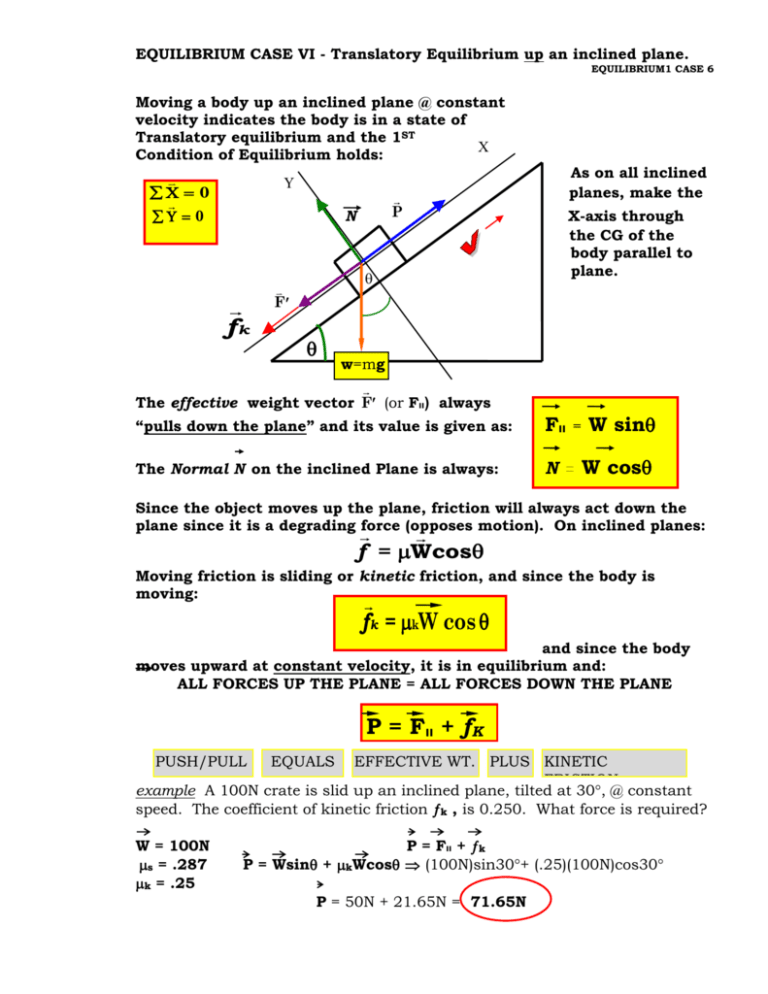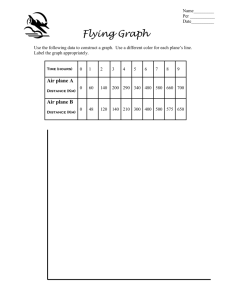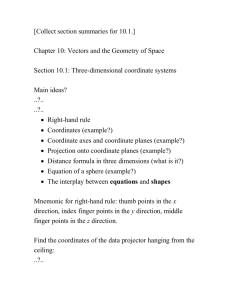Equilibrium Case 6-7
advertisement

EQUILIBRIUM CASE VI - Translatory Equilibrium up an inclined plane. EQUILIBRIUM1 CASE 6 Moving a body up an inclined plane @ constant velocity indicates the body is in a state of Translatory equilibrium and the 1ST Condition of Equilibrium holds: As on all inclined planes, make the 0 0 P N fk X-axis through the CG of the body parallel to plane. F w=mg The effective weight vector F (or F )װalways “pulls down the plane” and its value is given as: Fװ The Normal N on the inclined Plane is always: N W sin = W cos Since the object moves up the plane, friction will always act down the plane since it is a degrading force (opposes motion). On inclined planes: f = Wcos Moving friction is sliding or kinetic friction, and since the body is moving: fk = kW cos and since the body moves upward at constant velocity, it is in equilibrium and: ALL FORCES UP THE PLANE = ALL FORCES DOWN THE PLANE P = F װ+ fK PUSH/PULL EFFECTIVE WT. PLUS KINETIC FRICTION example A 100N crate is slid up an inclined plane, tilted at 30, @ constant speed. The coefficient of kinetic friction k , is 0.250. What force is required? W = 100N s = .287 k = .25 EQUALS P = F װ+ k P = Wsin + kWcos (100N)sin30+ (.25)(100N)cos30 P = 50N + 21.65N = 71.65N EQUILIBRIUM CASE VII - Translatory Equilibrium down an inclined plane. EQUILIBRIUM1 CASE 7 Moving down a plane @ constant velocity also constitutes equilibrium. y x 0 P N 0 fk Since the body slides down the plane, riction acts opposite of motion. To produce Equilibrium, a push P must be directed up the plane. F w=mg The effective weight F (F )װis always directed down the plane: Fװ The Normal on the inclined Plane is always: Again, moving friction is sliding or kinetic friction, and since the body is moving: = W sin W cos fk = kW cos ALL FORCES UP THE PLANE = ALL FORCES DOWN THE PLANE P + fK = Fװ example A 100N crate is to be lowered down an incline @ constant speed. The coefficient of s is 0.287 and the coefficient of k is 0.250. What force is needed? W = 100N s = .287 k = .25 P = F1 - k 1st let’s find the slip from: slip = tan-1 s slip = tan-1 0.287 = 16 This is the angle of an inclined plane needed to give an impending state of motion. The plane in this problem exceeds this 16 angle. The crate by its effective weight, will slide down the plane. To slide down the plane @ constant speed requires a push P , up the plane: P + k = F1 = Wsin - kWcos (100N)sin30 - (.25)(100N)cos30 P = 50N - 21.65N = 28.35N







